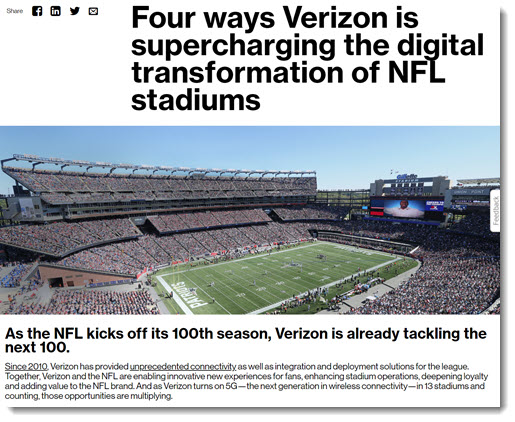
Previously: 5G Will Be Important, But Not In 2020
The carriers’ 5G upgrade will change our world over the next ten to fifteen years.
That’s not the message you’ll get from the onslaught of advertising in 2020, which will urge you to upgrade your phones and your mobile plans now now now.
The transition to 5G is a long-term project, and very little of it will be ready this year. During the transition, many things will be messy and confusing. Here are some of the things that won’t be in the ads.
5G has almost nothing to do with phones
A 5G phone with a 5G signal in 2020 will be exactly like your phone today. Additional speed and low latency will not change our experience on phones. If you have a decent signal, your phone is already fast enough.
There’s a standard pitch for 5G phones – seriously, I’ve read it dozens of times already. You’ll see it in ads and articles about 5G this year. “You’re standing in line at the airport when you remember you forgot to download a TV show for the flight. You’ll be able to download the entire season in a few seconds before you board the plane!”
Think about that for a second. Does that sound like something you want to do? So much that you’re ready to drop a thousand dollars on a new phone?
Yeah, me neither. It’s a distraction to keep you from noticing that the expensive new plan for your expensive new phone hasn’t changed anything that matters. And it’s a particularly misleading promise this year because none of the pieces will be in place by the end of 2020 for that to happen.
The only impact that 5G will have on our phones is that it will alleviate congestion as more devices flood onto the network. Nothing wrong with that, but the extra capacity won’t be available in very many places in 2020.
The carriers will lie

5G is complicated! The carriers will take advantage of that and lie about where it’s available and how effective it is. This year, coverage will be spotty; the carriers will not willingly tell you that much-vaunted 5G “improvements” are limited to very small areas.
AT&T has already set the bar. In early 2019, AT&T began aggressive advertising for its “5G E” network. It added a “5G E” logo to iPhones and Android phones when they connected to the “5G E” network. If you saw that, you would probably think it had something to do with 5G, wouldn’t you?
It was a lie. AT&T took its existing 4G network, rebranded it to confuse people, and came up with a bullshit explanation about “5G Evolution.” AT&T backed away pretty quickly when consumers discovered that the new network was the same as the old network. Competitors screamed bloody murder, and Sprint sued AT&T for false advertising and deceptive acts.
The next round of lies will be ever so slightly more subtle. For the next few years, as the carriers set up new equipment, they’ll lie about where 5G is “available.” You won’t know the details; all you’ll know is that your new 5G phone isn’t as cool as you expected.
Let’s try to do this as painlessly as possible. There are three types of 5G.
- “Low-band” covers relatively large distances, like current cell towers. For the most part, its speed will be very similar to your current 4G phone.
- “Mid-band” has decent speed, maybe better than 4G, but towers have to be no more than half a mile from each other.
- “Millimeter wave” supports the super-fast speeds that you’ll hear about in the ads – but only if the antenna is really close to you, and more or less in line-of-sight. Small 5G antennas will have to be mounted every 800 feet to provide seamless ultra-fast service. Oh, and millimeter wave 5G does not go through walls! It will be a long time before you can download movies in a flash in your home or in public buildings like they do in the demos.
The carriers have already begun a steady drumbeat of announcements of where 5G is “available.” Big cities will get low- or mid-band 5G coverage that is literally identical to the existing 4G service. Those announcements are hype, nothing more.
Meanwhile, densely populated parts of big cities – especially financial districts and technology centers – will slowly get high-speed millimeter wave antennas mounted on lamp posts and attached to buildings.

Want to know how that will work? The recent debacle at football stadiums will give you the idea. In September, Verizon breathlessly announced that it was turning on 5G in 13 football stadiums, to “deepen engagement, optimize operations and delight customers.” Wow! It would even keep the hot dog line moving! Mainstream news outlets like USA Today picked up the story and amplified it.

Funny thing about the reality when journalists parsed the words of the announcement and asked the right questions. In a heavily promoted demo of a “supercharged digital transformation,” Verizon couldn’t even cover an entire football stadium. “The network is only able to cover ‘parts’ of the seating areas. Verizon 5G signals will also be sparse or non-existent when fans walk through concourses and other areas in and around each stadium.”
During 2020, 5G coverage will be more like a public beta test than a final product. The carriers have to do expensive upgrades to their base stations to improve coverage, speed, and reliability, even if technically they add long-range 5G antennas. There will be an announcement that 5G is now available in some major city when the reality is that only a small area of downtown has 5G coverage, and only for people standing outside.
One more thing: for the foreseeable future, the carriers’ upgrade efforts will be focused nearly exclusively on large cities. Rural areas will be left behind – way behind.
5G phones and other equipment will be a mess
In 2020, the phone carriers will push 5G phones hard, culminating in Apple’s announcement of 5G support in the next iPhone.
The three flavors of 5G perform very differently from each other – and for the next year or more, you will have no guarantee that a new 5G phone will support all three of them. Each carrier is deploying 5G differently, and your next phone might not support the full network that your carrier is building.
Most of the upcoming 5G phones will run hot and have miserable battery life. At the moment, 5G chips are power hogs. From Android Central: “5G already creates a bit of additional battery drain and generates a ton of heat, and the need for yet another chip inside of your phone means less room for a large battery. That’s only going to exacerbate battery-related complaints with small phones. Things have to get worse before they can get better, and 2020 is the year things will get worse. ” New 5G chips might improve performance and battery life later this year.
Will 5G rays cause brain cancer and make all the frogs gay?

No, but you’re going to hear 5G conspiracy theories from deeply stupid people, because that is our world.
Tell them to get a grip and focus on the real danger – chemtrails. Better to be safe than sorry – stock up on tin foil hats.
Should you avoid 5G?
No need to avoid 5G. It’s at risk of being overhyped but it’s good technology.
If you need a new phone in 2020, a 5G phone will likely be a good choice for the long run, especially when the hardware is more settled later this year.
But don’t let the 5G hype convince you to upgrade if you don’t otherwise need to do that.
Let’s talk again about 5G in 2021. Until then, remember: skeptical curiosity.

Press Release
For release Tuesday, April 21, 2020
The FIBERGATE Scandal
Telecoms raised prices and collected extra fees on phone bills for decades, promising to build a national fiber-optic network. They never finished it. Now they want billions more to build out their (more profitable) wireless network instead. Thousands of Americans are saying NO!
(New York, NY) Telephone customers across the country who have been paying frequent price increases and extra fees on their phone bills for years to finance a national fiber optic network are today demanding that the FCC refuse to grant telecoms $9 billion to build out their 5G wireless networks until they complete the fiber-optic network they have been promising since the 1990s. More than 100 organizations representing thousands of Americans are participating in the campaign.
On Thursday, the Federal Communications Commission (FCC) plans to announce a $9 billion “5G Fund for Rural America,” to support the deployment of 5G mobile wireless broadband and voice services. This is designed to bring broadband to some of the most rural parts of the country, where, the agency claims, there is not a “business case” for providing the service.
“If the phone companies had finished building out the fiber-optic network they promised years ago, there would be no rural divide,” says Bruce Kushnick, a former telecommunications analyst turned whistleblower, whose organization, IRREGULATORS, is taking legal actions to recover billions from the telecoms for consumers. “There would be no urban divide, and we wouldn’t be hearing about the ‘homework divide’ either, because everyone in America would be hooked up to a low-cost, ultra-reliable, secure and safe fiber-optic network.”
“It’s outrageous that the telecoms are using this national emergency to try to get billions from the government to build out their private wireless networks,” says Doug Wood, founder of non-profit Americans for Responsible Technology, which advocates for curbing the deployment of 5G. “These companies collected billions in fees from hard-working Americans, and then stiffed them
out of the fiber-optic network they paid for. The FCC has no business helping those who have already helped themselves.”
Critics of the multi-billion-dollar fund for 5G say fiber-optic networks are faster, more reliable, more secure, and have none of the RF exposure issues associated with wireless technology. Over the past few years there has been a growing consumer backlash against the deployment of 5G “small cell” antennas, especially in suburban areas where homeowners fear declining property values. Town boards from New York to California are electing to deny permits and risk lawsuits from wireless companies because of citizen objections to the 5G build-out.
More information: http://irregulators.org
Listen to the podcast: https://www.greenstreetradio.com/post/the-big-telecom-swindle
Media Contacts:
Doug Wood, Grassroots Communications, daw@grassrootsinfo.org Bruce Kushnick, IRREGULATORS, bruce@newnetworks.com
Upgrade?? Too right, I need to upgrade.
My carrier in remote Australia will be turning off the 3G network in 2024 – I’d better move quick.
My 3G phone is just fine for voice calls and text messages. What more could I need?